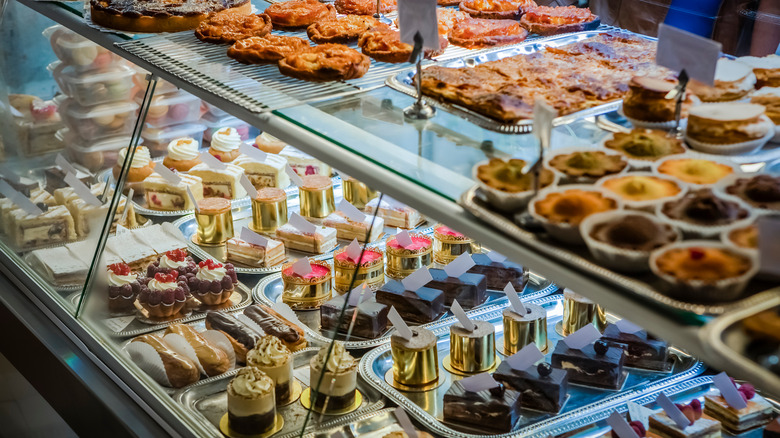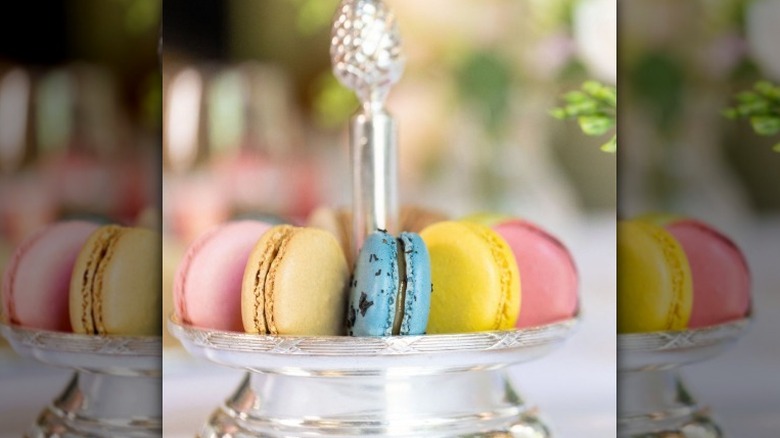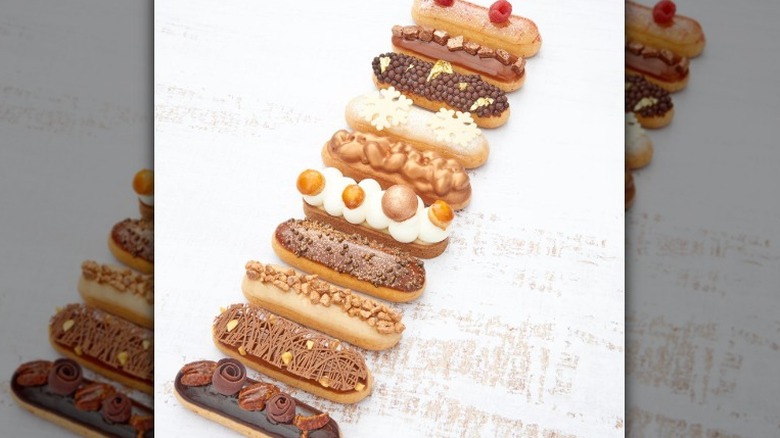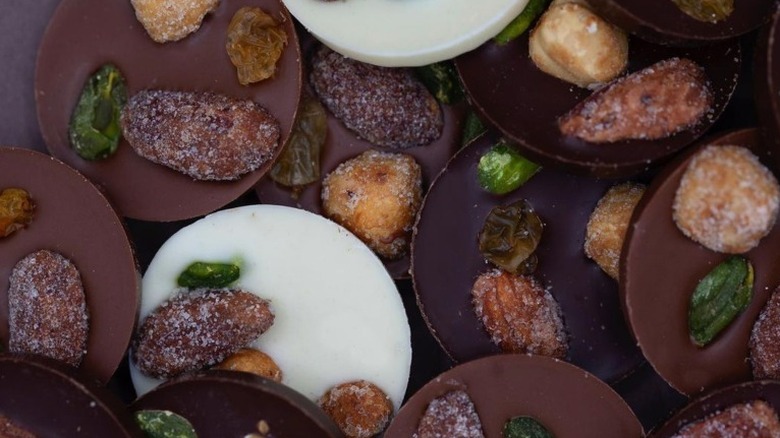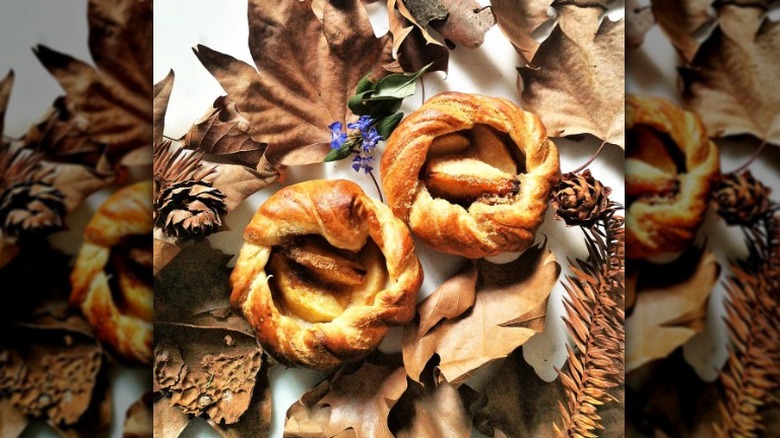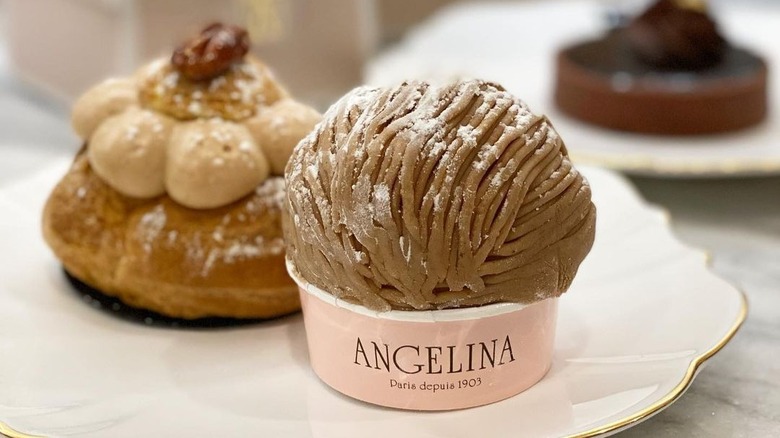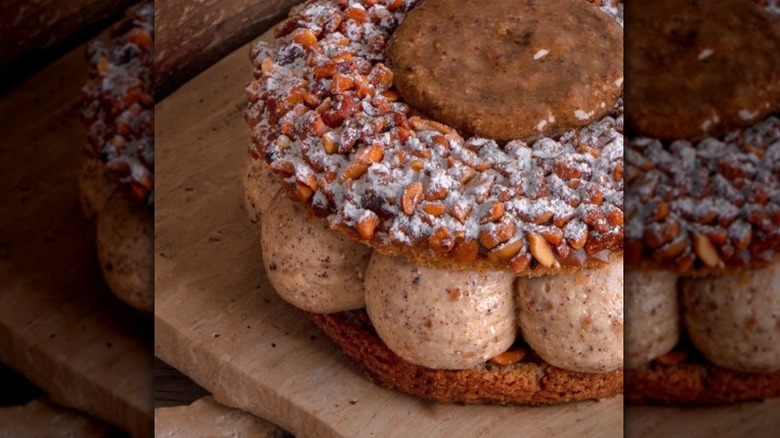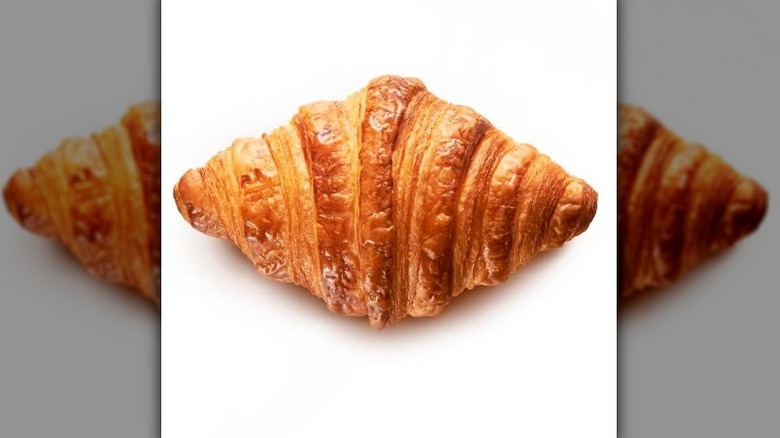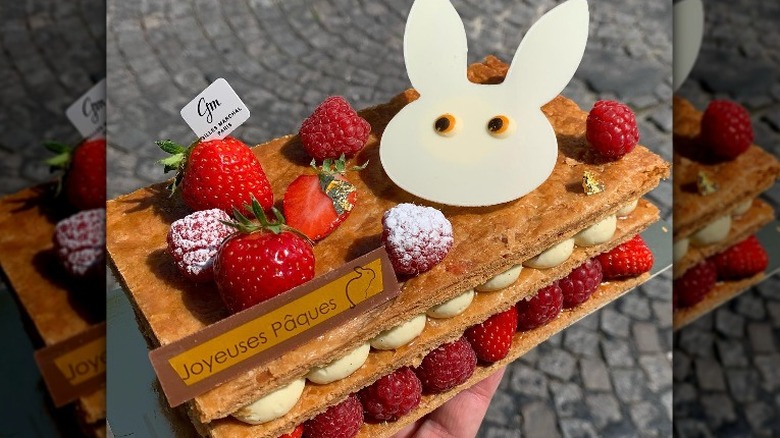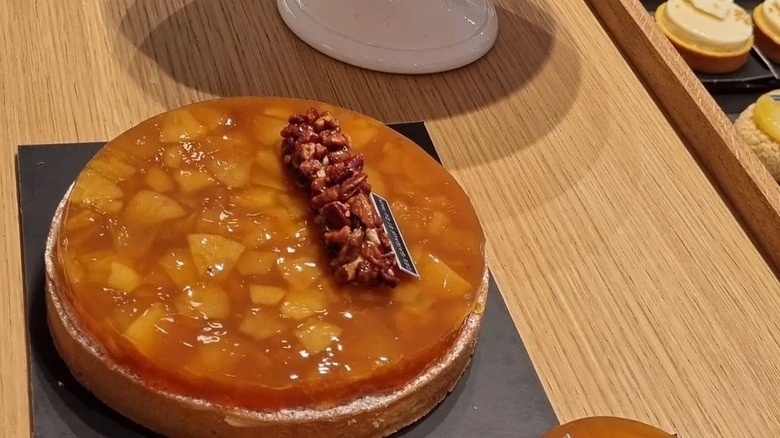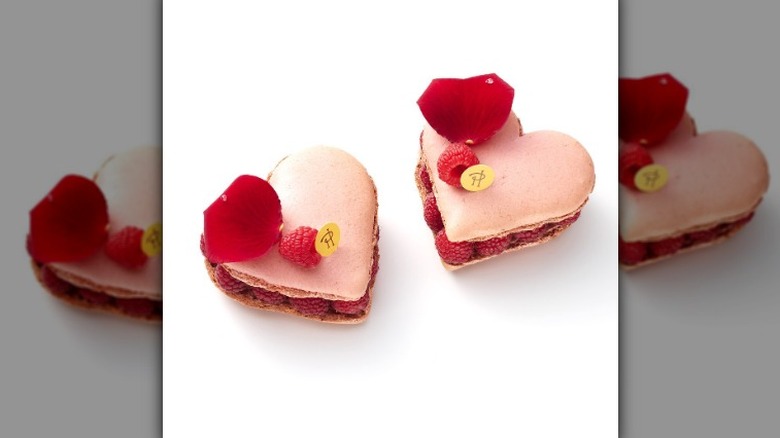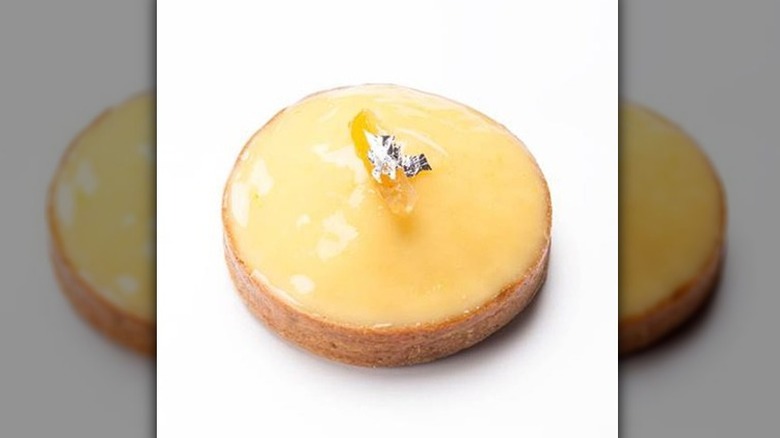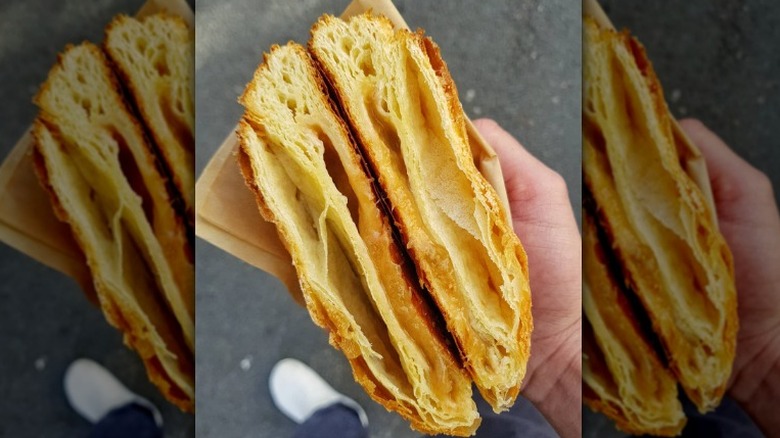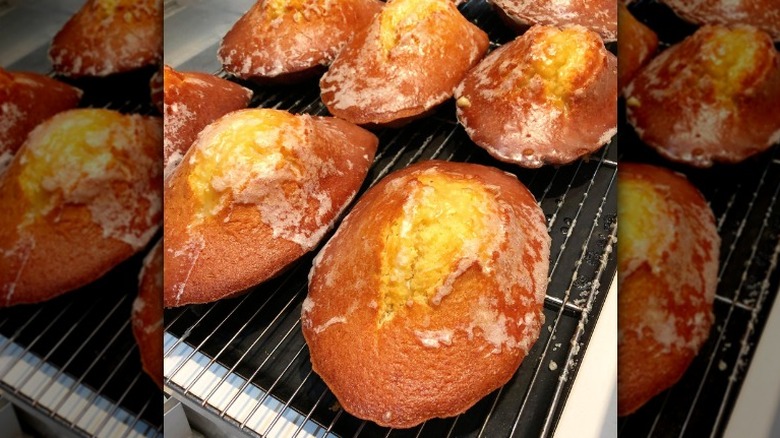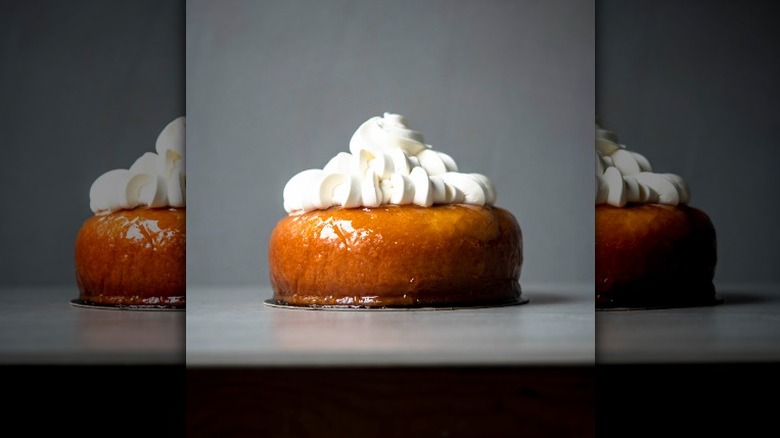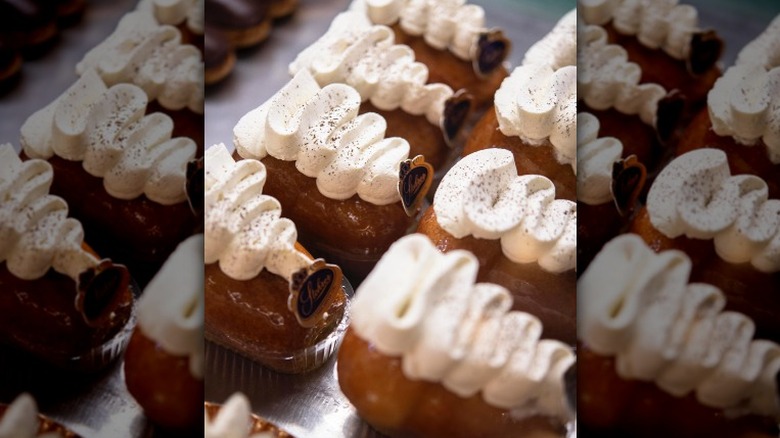15 Best Pastries To Eat In Paris, France
One of the best ways to get to know a city or a culture is by eating your way through it with unapologetic gusto and enthusiasm. Take note of what and how ingredients are used, what seems to be valued within the cuisine or culture, and how trends and influences have changed over time. Think of it as one delicious history lesson.
The same can be said when visiting Paris. Though there are many current trends in the Paris food scene and lots of savory French dishes you need to try at least once, it's still home to many pastries we now consider classic French cuisine, from delicate macarons to yeasty croissants to rum baba. When walking around the city of love (or taking the metro, but we think a city is always best on foot, and Paris is largely walkable), tasting a mix of old and new is a beautiful way to get to know the city. Our list below features many of its well-known treats and patisseries, including how they started, what to try, and how the baton is being passed to some of the newer and innovative bakers working to combine the past with the future. Bon appetit.
Macarons from Ladurée
It would border on criminal to put together a pastry-centered guide to Paris and not mention the historical Ladurée founded in 1862 by Louis-Ernest Ladurée. Ladurée started life as a bakery before rebranding and refocusing following a fire and an emerging luxury artisan market in Paris.
However, it wasn't until the 1930s that what we now know as the macaron came to life, thanks to the work of Pierre Desfontaines, incidentally related to Ladurée himself, who put the delicately crisp almond-based shells together, to create one of Paris's most loved treasures. The rest, as they say, is history. Over 160 years of it, to be exact.
Though Ladurée macarons are now sold in a variety of countries and can even be ordered online, there is nothing quite like a trip to one of the shops in Paris to hand select each colorful pastry yourself, to be gingerly placed into a box, wrapped up beautifully, and handed back to you like a precious gift. Everything about the experience, from beginning to end, feels luxurious and exceptionally Parisian. There are, of course, other delights to choose from, including chocolates and pastries, but you can never go wrong with a Ladurée macaron.
Eclairs from L' Eclair de Génie
Founded and run by chef Christophe Adam, L'Eclair de Génie declares its mission is to take the traditional French pastry and make it a bit more 'rock' n roll. Eclairs come in playful flavors and colors as Adam draws inspiration from other areas of the world and then reinterprets the tastes with French products. Having been named among Vanity Fair's 50 most influential French people in the world in 2017, this is a name and product that's been well vetted, making it an easy decision when wondering where to sample an eclair when in Paris.
No longer just in France, you can also find a taste of Paris in various other cities, including Beijing and Abu Dhabi. Flavors are often thematic and tied to various holidays, incorporating all the colors of the rainbow, from passion cream and pineapple to pistachio, double chocolate, and pumpkin cream. With several shops dotted around Paris, there's no real reason not to pop in and be instantly delighted.
Mendiants from À la Mère de Famille
À la Mère de Famille takes the 'family' part of its title seriously. Etienne Dolfi, originally from Alsace, took over the business in 2000 after first being a supplier. Today, it is run by Dolfi, his two daughters, Sophie and Jane, and two sons, Jonathan and Steve. À la Mère de Famille is a confectionery and chocolate lover's dream with a long history of being a family-run business with an inherited sweet tooth. It was first founded in 1760 by Pierre Jean-Bernard, who soon brought his family into the business.
While you can't make a wrong choice here, mendiants, also called beggars, is a classic, almost rustic (in French terms, anyhow) chocolate dotted with dried fruit and nuts. Despite their seeming simplicity, they encompass all the necessary elements of the perfect bite of sweetness, complimented by the satisfying texture of the nuts. Here you can pick up a box of mendiants on their own or find them within a diverse selection of specialties, including florentines and other French classics.
Tarte a pomme from Poilâne
Run by third-generation baker Apollonia Poilâne, the Poilâne bakery has been turning out freshly baked treats since 1932. First, it was Pierre, then Lionel, and now Apollonia at the helm, still using its unique wood-fired oven for its signature baked goods, bread, and pastries.
Poilâne is known for its dedication to natural ingredients and tradition. All the bread is made using sourdough as a leavening agent, from options like rye loaf with grapes to their traditional round loaves. The tarte a pomme is wonderfully rustic and equally delicious, as you would expect. Made using handmade puff pastry and high-quality apples, this pastry showcases the high quality of the ingredients without any need for extra whistles and bells. However, we wouldn't say no to a scoop of vanilla ice cream or fresh cream to top off the dish. If you can't make it to Poilâne, there's also the option to bring Poilâne to you, thanks to national and international delivery options.
Mont Blanc from Angelina Paris depuis
Angelina Paris Dupuis was initially opened in 1903 as a father-son partnership by Anton Rumpelmayer, a successful Austrian entrepreneur, and his son Rene, named after Rene's wife, Angelina. Angelina Paris depuis has a history and a place in the city of Paris; it opened when the city was rich with the creative influence of writers, painters, and poets. Angelina's was considered a place only for the cultured high society. Its decor reflects the art nouveau of that era, inspired by the Riviera.
With chef Erwann Le Guerroué at the helm, Angelina Paris straddles French patisserie tradition while bringing new, savory dishes like croque madam or the prettiest avocado toast we've ever seen, into the kitchen. That being said, Angelina's is famous for its Mont Blanc, a decadent, creamy dessert of meringue whipped cream covered with a sweet, thin, chestnut cream vermicelli. The recipe was created when Angelina's first opened and continues to remain the same.
Paris Brest from Yann Couvreur
The Paris Brest is, more or less, an ode to the hazelnut in refined French pastry form. Traditionally, the pastry began as a crisp, wheel-shaped choux pastry that makes up the base, filled with creamy hazelnut praline and topped with a crunchy layer of almonds. However, many patisseries around Paris and throughout France have added their own indulgences and signatures, like Yann Couvreur, which adds a roasted hazelnut nougatine and a salty hazelnut praline to create a textural and taste explosion.
Pastry chef Yann Couvreur opened up shop following extensive career training in some of the finest kitchens, from Alain Dutournier to Jen-Francois Foucher. Couvreur's millefeuille, infused with Madagascan vanilla, helped Couvreur to create a name for himself by winning the title of "Dessert of the Year" by the 2014 LEBEY guide. And while it would be perfectly acceptable to order one or two of these award-winning millefeuille, we think you should save room for a Paris Brest, too.
Croissant from Laurent Duchêne
With four shops around Paris, Laurent Duchêne offers the security that you're never too far away from one of the delicious croissants, bread, cakes, and sweet or savory pastries. An all-butter, flaky, yeasty croissant will only set you back €1.40, which means there's just no good excuse to eat poorly in this city.
Founder and pastry chef Laurent Duchêne has a long history of exceptional training in Michelin-starred restaurants, having taught students all he knows at Le Cordon Bleu before venturing into the entrepreneurial world and opening up his first co-founded boutique in 2001 with renowned pastry chef and partner Kyoto Duchêne. Duchêne's reputation precedes it, with shops often selling out of croissants quite early. We recommend making it a first point of call if you plan to pastry hop your way around Paris or simply want a delicious breakfast or snack on the go.
Millefeuille from Gilles Marchal
Gilles Marchal patisserie, named after its pastry chef founder, takes its ingredient sourcing incredibly seriously to ensure the highest quality pastries, cakes, madeleines, and cookies come out of the kitchen. The origins of ingredients are detailed right on the website, including free-range eggs and organic French flour.
Choose from classic French pastries, including our pick, raspberry or vanilla millefeuille. Millefeuille, which translates to mean 1,000 layers, is in reference to the paper-thin sheets of puff pastry that make up the body of the dish. It's a dish that naturally requires the utmost patience and technique to perfect, which is one of the reasons it feels so classically French. Marchal was named pastry chef of the year in 2004 and medalist of the city in 2008, so there is likely to be no wrong choice when stopping by his beautiful shop in Montmartre, a neighborhood bursting with creative inspiration and artistry.
When selecting one of the refined sweet millefeuille pastries, you can enjoy it on its own or add a luxurious helping of vanilla custard or red fruit coulis to add indulgence. Are you looking to add a second pastry to your order? Marchal's is also renowned for its kouign amann, oozing with butter.
Pomme tarte tatin from Des Gâteaux et du Pain
The pomme (meaning apple) tarte tatin is one of the most talked about offerings from the chic Parisian patisserie Des Gâteaux et du Pain. With organic apples selected from Brenton, combined with organic eggs, French flour, and a generous amount of butter, then scented with organic maple syrup, this magical combination feels like a dedication to some of life's greatest pleasures, displayed in an artistic, edible form. Crowds (us included) flock to this treat, when in season, for a taste.
Des Gâteaux et du Pain produces work that feels almost too beautiful to eat, featuring an array of pastries whose contents follow the seasons. Led by pastry chef Claire Damon, known for incorporating fruit and vegetables into her pastries, it's no surprise to see she's outdone herself with this interpretation of a classic French tarte tatin. Damon's experience, including an apprenticeship with Ladurée, has helped pave her path to where she is today. And, while there are indeed no bad choices here, given Damon's love of fruit and her ability to celebrate all of its flavors, we recommend turning your attention to a fruit-based pastry, namely this one, when available, for a truly memorable experience.
Ispahan from Pierre Herme
Swing by Pierre Hermé for a taste of one of its signature pastries, one of the few available year-round. Depending on tastes and preferences, customers are spoilt for choice. Still, one of the spot's most famous is the ispahan, a classic French pastry that combines three beautiful flavors, rose, raspberry, and lychee, to create a final product that is as pink as it is delicious. Here you can choose to have your own ispahan all to yourself or choose a sharing option for those feeling more generous.
Pierre Hermé comes from a lineage with French flour and butter coursing through its DNA. Hermé is a fourth-generation pastry chef. Inheriting his love of patisserie from those before him, Hermé began his career at 14 and hasn't stopped since. Having first worked with Ladurée to perfect the macaron, Hermé then forged his path and opened the Maison Pierre Hermé Paris in 1998. Should the floral-meets-fruit combination showcased in an ispahan not be to your taste, you also can't go wrong with a macaron or several, as Maison Pierre Hermé is also famous for its flavors, not a surprise given its founder's training and experience.
La Tarte au citron from Carl Marletti
Carl Marletti is a shop worth seeking out while in Paris. Though not as large as others on this list, nor is it in multiple locations, but rather in the 5th Arrondissement, known as the Latin Quarter, its size is no reflection of the quality of treats produced daily.
Marletti is known for his playful twists on the classics, with infusions of flavors like yuzu into a classic tarte au citron, or his vibrantly violet-colored le lily valley, whose look reminds us of the hats and fascinators found at a regal British wedding. We love the wild combination of disciplined technique meets wild imagination.
While we can't in good conscience recommend showing restraint with just one purchase while visiting the shop, when it comes to the classics, Marletti took home silver from Cannes Dessert Prize in 2020 for its tarte au citron, made with a shortbread base and sweet-yet-tart lemon filling. It's an excellent jumping-off point, especially when purchasing a flight of pastries, which we highly encourage.
Chausson aux fruit or Black Sesame anything from Boulangerie Utopie
Sometimes, when it comes to pastry, simplicity is the star ingredient. Such is true of a chausson aux pommes or apple turnover. Only a few key elements are necessary: roasted apples, a bit of sugar, and a deliciously flaky puff pastry. Together, these simple ingredients (not that the making of the puff pastry itself is simple) create something bigger and more delicious than the sum of its parts.
Boulangerie Utopia is worth a stop for a chausson aux pomme or almost anything else. Founded in 2014 by Erwan Blanche and Sébastian Bruno, who met in pastry school, their products are a delicious result of technique meets creativity. Boulangerie Utopie, defined by the founders, is a place where locals can shop for their daily bread and viennoiserie, French pastries known for their yeasty, flaky nature, such as croissants. Traditionally these goods are sold separately in France by two different specialist shops, but Blanche and Bruno wanted to change that by offering customers a one-stop-shopping experience that doesn't sacrifice quality. Anything the shop makes using laminated dough is worth a purchase. Its creative use of black sesame, from tarts, to bread, and cakes, is also worth looking at (and tasting), in our opinion.
Madeleines from Blé Sucré
Compared to many other French offerings, madeleines can often fly a bit under the radar. They make for the perfect light, slightly buttery, sweet snack — just big enough and sweetened enough to scratch an itch for something sweet (and there's even a sweet trick to give your madeleines the perfect bump).
Where better to pick up a few than Blé Sucré, a place known for also flying a bit under the radar? Without a website and with the appearance of an "everyday bakery," it's a bit of a dark horse of this list, producing pastries that taste anything but every day. You just have to know about it. However, residents of the 12th Arrondissement, where the shop sits, would likely be happy to keep the secret (and baked goods) to themselves.
Despite the lack of a website, the word does get around, thanks to the power of the internet and social media. Stop by for an iced madeleine or two and pick up other treats, like the kouign amann, another local favorite.
Rum baba from The French Bastards
Despite its now-French associations, Baba au Rhum or Rum Baba is not of French origins but rather Polish babka, eventually becoming soaked with rum: The results of which are ultimately thanks to an exiled king. Though signs point to the founder and patissier Nicolas Stohrer, whose shop is also on this list, so popular was the booze-soaked, cream-filled specialty at The French Bastards that, due to demand, it went from being a weekend specialty to an everyday menu item. Thanks to the shop's vocal customers, that means more opportunities for everyone to get their hands on the coveted item.
The French Bastards are a trio of bakers Julien Abourmad, David Abehsera, and Emmanuel Gunther. Together, they're working to add a bit of rock 'n roll flare alongside a burst of creativity into the classic and often restrained French baking scene.
The term bâtard initially referred to a type of French bread that was thought to have an in-between, almost structureless form almost like an American football. It now has more nefarious associations, none of which apply to the folks running or working the business here. It's a good name, though. While starting with just one location, you can now find all the baked goods in three locations around Paris.
Baba chantilly from Stohrer
As the official oldest patisserie house in Paris, Stohrer was a must-have on our list. Founded in 1730 by Nicolas Stohrer, pastry chef to King Louis XV, and known as the creator of Baba au Rhum, its legacy, heritage, and dedication to French pastry traditions make it practically unparalleled. While history buffs would be remiss to pass up their original rum baba, we think a baba chantilly might be even better.
Rum baba, as mentioned earlier, has its roots in Poland's babka, with Stohrer making a name for himself by soaking the brioche-like dough in rum. The baba chantilly contains everything you know and love about a rum baba, plus the addition of swirls of sweetened cream for an extra layer of decadence.
Visit Stohrer in the exact location as its original, on rue Montorgueil in the 2nd Arrondissement. Want to attempt to make a baba au rhum or baba chantilly yourself? The "Stohrer Baking Book" offers step-by-step instructions to help readers navigate the process in the hopes of creating the classic in the comfort of their homes.
